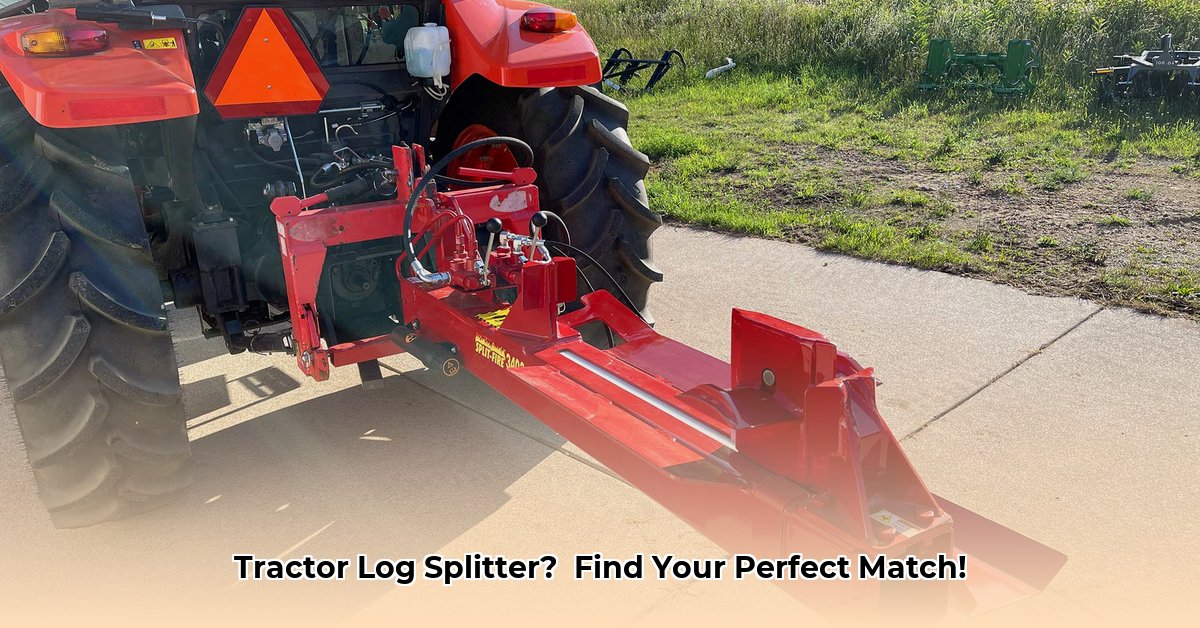
Choosing the Right Tractor Log Splitter: 3-Point Hitch vs. PTO
Tired of wrestling with stubborn logs? A tractor-powered log splitter can transform this arduous task into efficient firewood production. This guide helps you navigate the key differences between the two dominant types: 3-point hitch and PTO (Power Take-Off) systems. We'll compare their power needs, hydraulic requirements, costs, ease of use, and maintenance, empowering you to make an informed decision. For more information on tractor log splitters, check out this helpful resource: Tractor Log Splitters.
3-Point Hitch vs. PTO Systems: A Comparative Analysis
Both systems leverage your tractor's power, but their methods differ significantly. Understanding these differences is crucial for selecting the right splitter for your needs and tractor capabilities.
3-Point Hitch Systems: These splitters directly attach to your tractor's three-point hitch, utilizing the tractor's existing hydraulic system.
- Pros: Simple setup, relatively lower initial cost, no need for an additional hydraulic pump.
- Cons: Demands a powerful tractor with a robust hydraulic system (sufficient gallons per minute (GPM) and pressure (PSI)). Insufficient hydraulic capacity leads to slow operation or even damage to your tractor. Requires a higher horsepower tractor.
PTO Systems: These systems use your tractor's PTO shaft to drive a separate hydraulic pump, powering the log splitter independently.
- Pros: Less demanding on your tractor's hydraulics, making it suitable for smaller tractors. Potentially offers higher splitting power due to independent pump control.
- Cons: Higher initial cost due to the separate hydraulic pump, more complex setup and maintenance. Requires a PTO-capable tractor.
Here’s a summary table:
| Feature | 3-Point Hitch | PTO System |
|---|---|---|
| Power Source | Tractor's Hydraulic System | Separate Hydraulic Pump (PTO-driven) |
| Setup | Simple, direct connection | More involved, includes pump installation |
| Initial Cost | Lower | Higher |
| Tractor Needs | Powerful tractor, sufficient hydraulics | Less demanding on tractor's hydraulics |
| Maintenance | Generally less maintenance | More components mean more potential maintenance |
Isn't it important to understand the long-term costs involved? Maintenance is a crucial factor to consider that can significantly impact your overall investment.
Choosing the Right Log Splitter: A Step-by-Step Guide
This section provides a structured approach to selecting the optimal log splitter.
Step 1: Assess Your Tractor's Capabilities: Consult your tractor's manual for its horsepower, GPM, and PSI ratings. This information is paramount for compatibility.
Step 2: Evaluate Your Needs: Consider the volume of wood you'll split annually (quantity of cordwood) and the size of logs you frequently handle. Larger logs require more powerful splitters.
Step 3: Set Your Budget: Factor in not only the initial purchase price but also potential additional costs like the hydraulic pump (for PTO systems) and ongoing maintenance.
Step 4: Prioritize Ease of Use: A 3-point hitch system generally offers simpler operation; consider your experience level with machinery.
Step 5: Safety First: Always wear appropriate personal protective equipment (PPE), including safety glasses, gloves, and hearing protection. Read and understand the manufacturer’s safety instructions before operating the splitter.
Safety Precautions: Minimizing Risks While Splitting Wood
Safety is paramount when operating a tractor-powered log splitter. Always:
- Engage your tractor’s parking brake.
- Wear appropriate PPE (personal protective equipment).
- Keep bystanders at a safe distance.
- Never reach into the splitting area while the machine is operating.
- Regularly inspect hydraulic lines and connections for leaks.
Maintenance and Troubleshooting: Extending Your Splitter's Lifespan
Regular maintenance significantly extends the lifespan of your log splitter. This involves:
- Lubrication: Regularly lubricate all moving parts according to the manufacturer's recommendations.
- Hydraulic System Checks: Inspect for leaks and ensure all fittings are secure.
- Cleaning: Keep the unit free of debris.
- Consult the Manual: For troubleshooting, always refer to your operator's manual.
Did you know that regular lubrication can increase the lifespan of your log splitter by up to 25%? This simple maintenance step yields significant benefits.
Conclusion: The Perfect Log Splitter Awaits
Selecting the perfect tractor log splitter demands careful consideration of several factors. By thoroughly assessing your tractor's capabilities, your splitting requirements, and your budget, you can confidently make a decision that will streamline your firewood production for years to come. Remember, safe operation and regular maintenance ensure both efficiency and longevity.